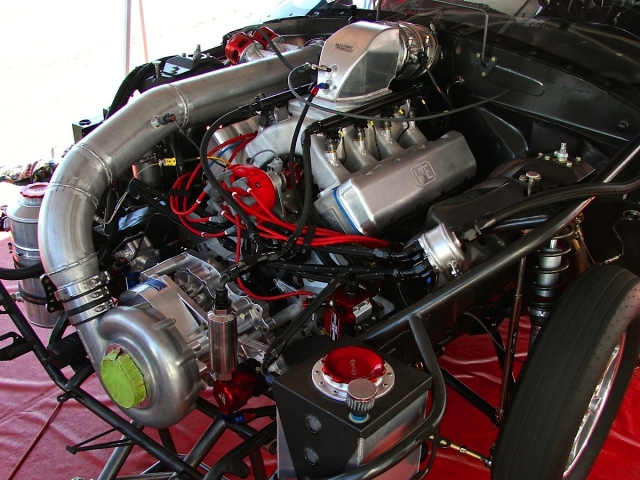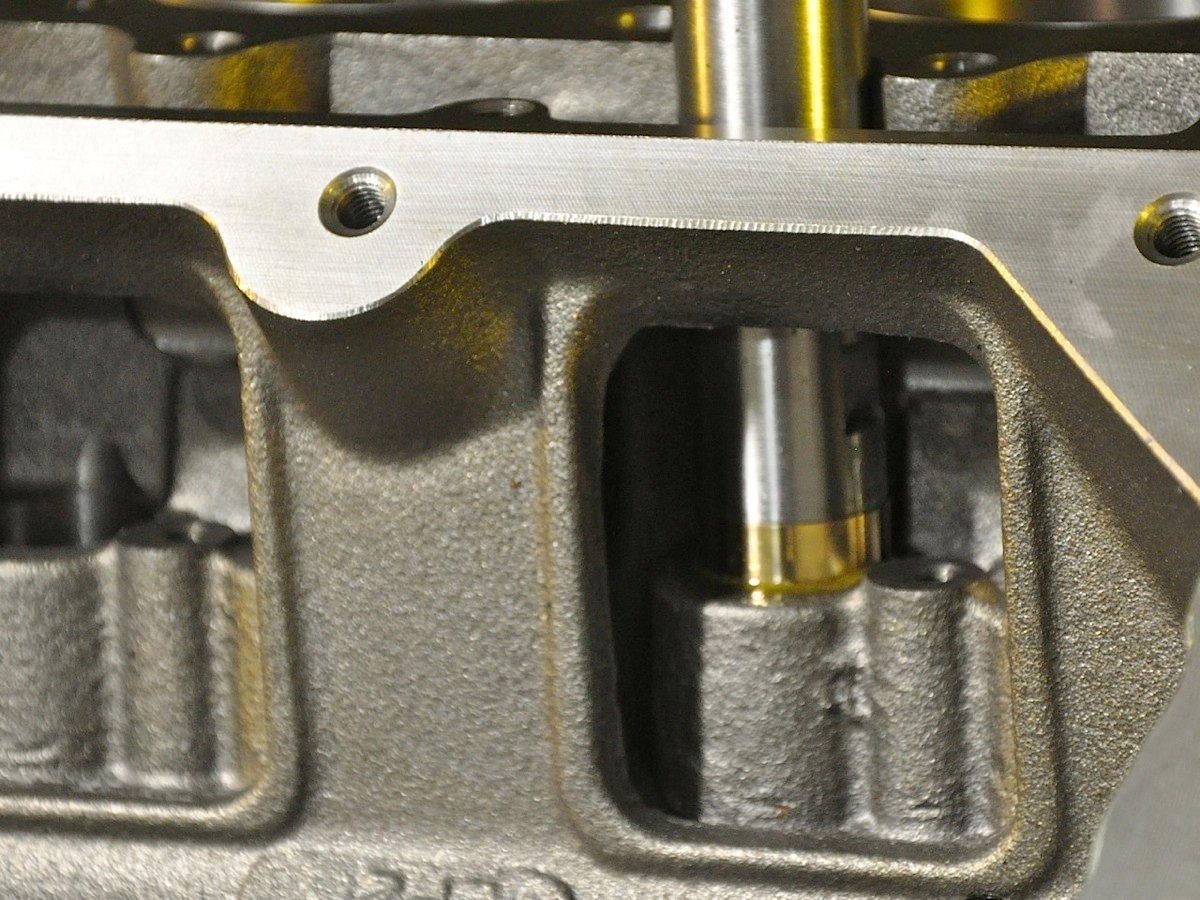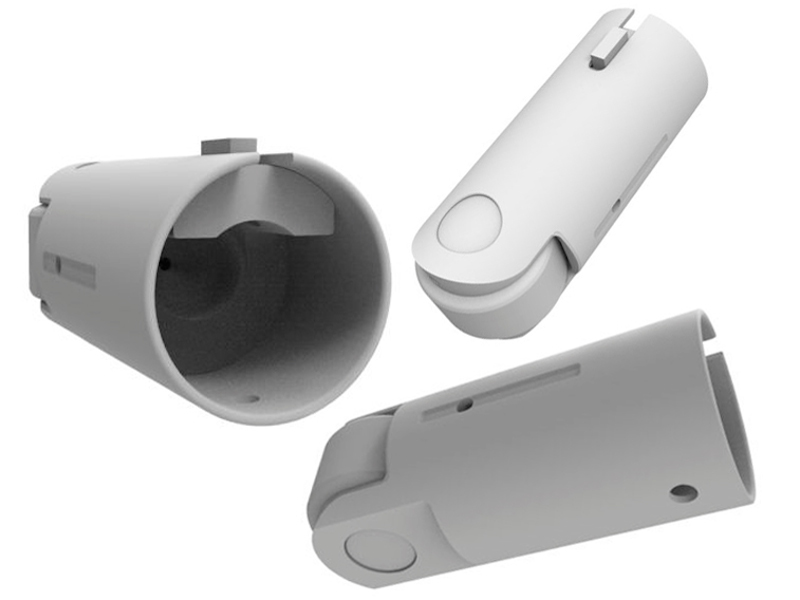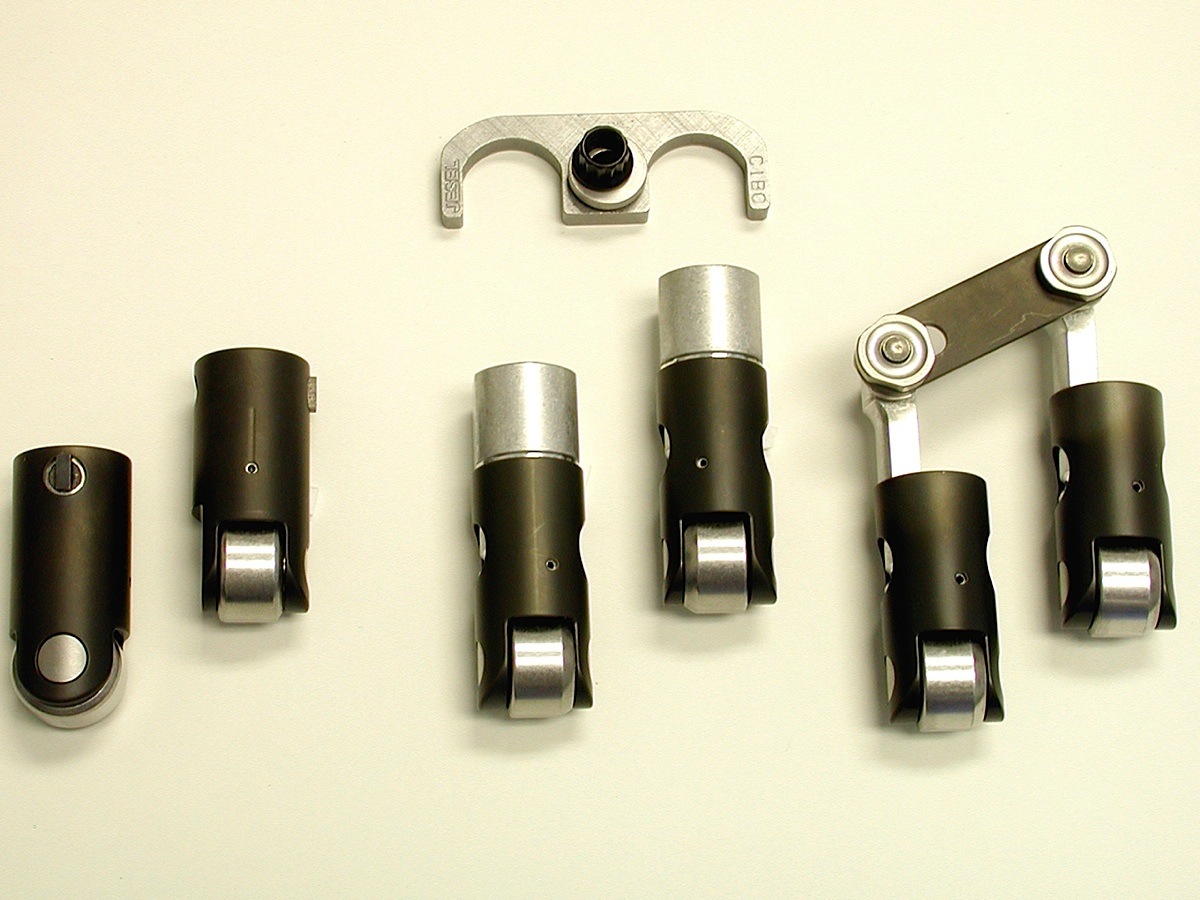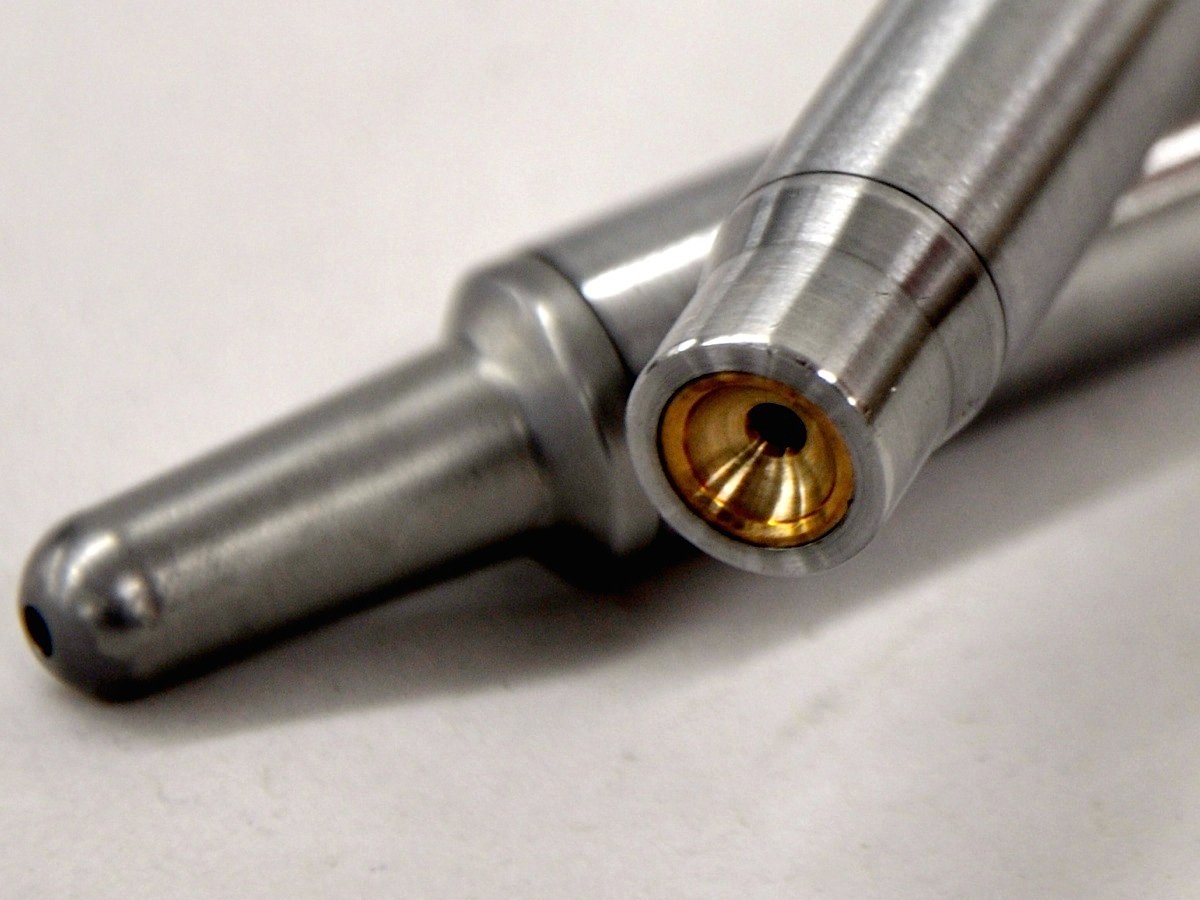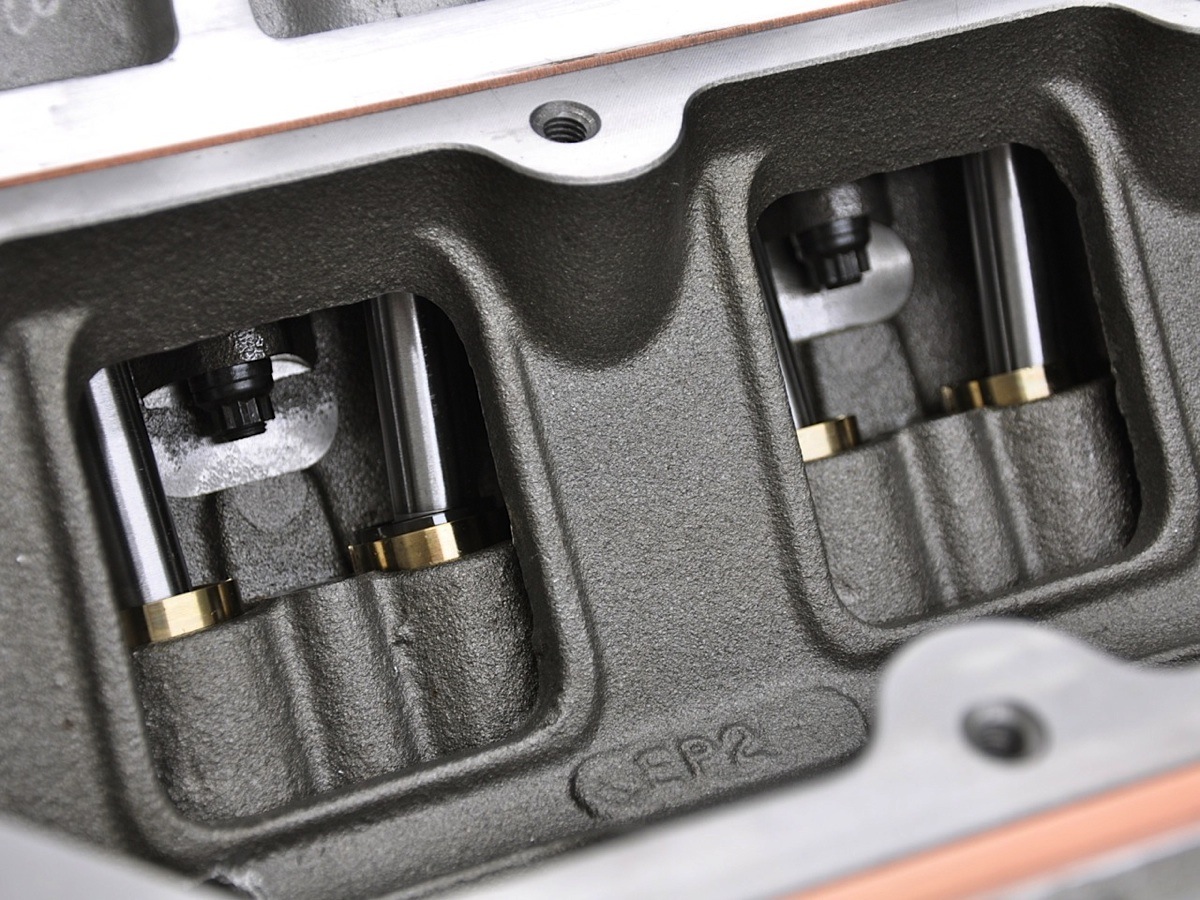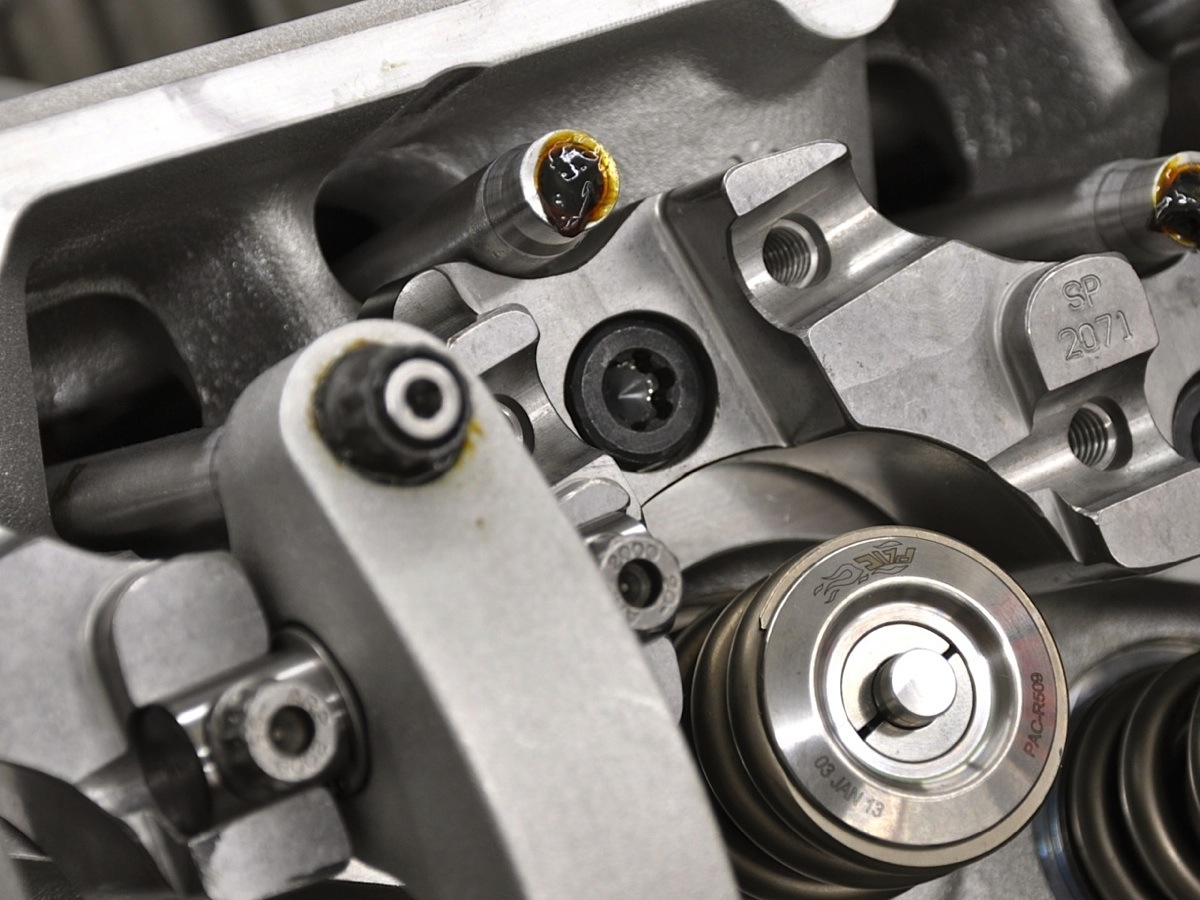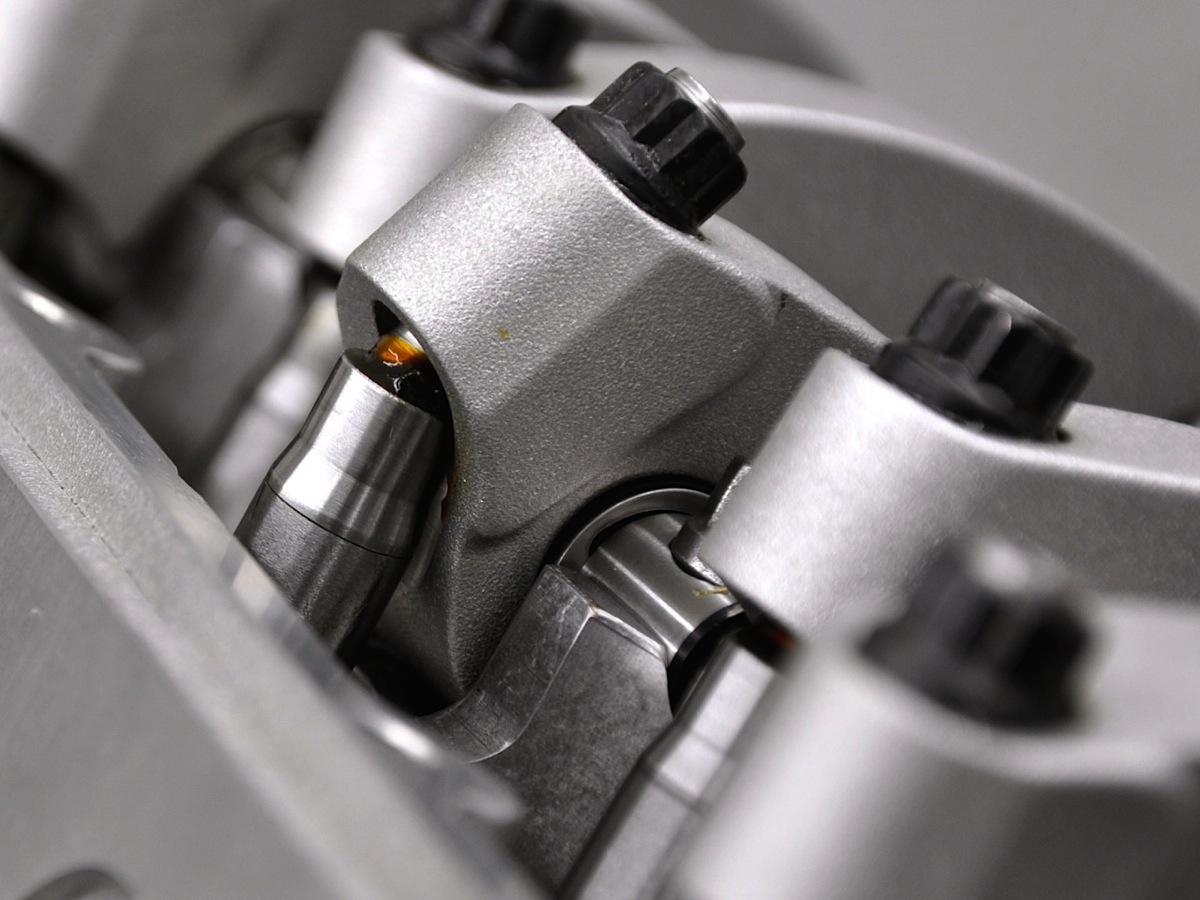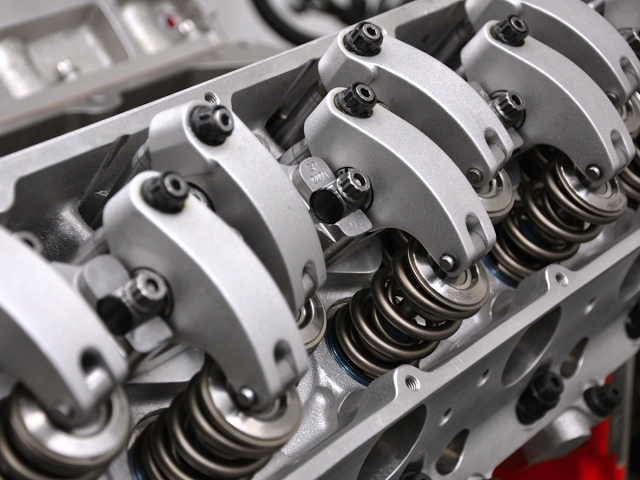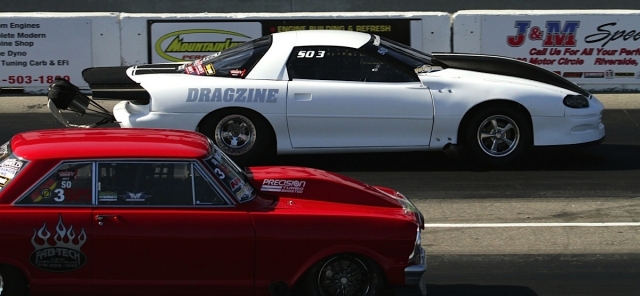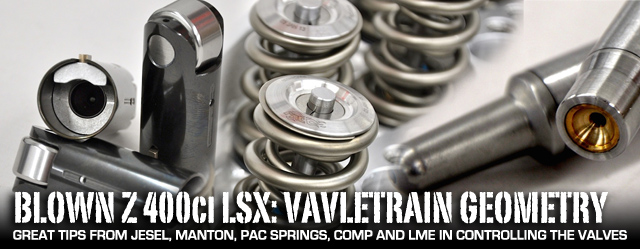 [1]Increasing the engine’s usable rpm range is the fundamental direction that Late Model Engines [2] followed to maximize horsepower for the 2014 season in a new supercharged 400ci LSX V8 built for Project Blown Z [3]. As noted in a previous story covering the assembly [4], LME wanted to turn “more rpm than others in the class.” Quite simply, more rpm translates into more horsepower. With corresponding changes to gearing and shift points at the drag strip, more rpm also translates into quicker elapsed times and higher trap speeds.
[1]Increasing the engine’s usable rpm range is the fundamental direction that Late Model Engines [2] followed to maximize horsepower for the 2014 season in a new supercharged 400ci LSX V8 built for Project Blown Z [3]. As noted in a previous story covering the assembly [4], LME wanted to turn “more rpm than others in the class.” Quite simply, more rpm translates into more horsepower. With corresponding changes to gearing and shift points at the drag strip, more rpm also translates into quicker elapsed times and higher trap speeds.
No single discipline of race-engine development in the past two decades has contributed to increasing rpm limits of 2-valve engines more than the tremendous improvements in valvetrain technology. NASCAR’s flat-tappet engines are hitting 10,000 rpm and 500ci Pro Stock bullets are banging past 11,000 rpm these days — mostly due to huge advancements in cam profiles, pushrod design, valvetrain geometry corrections and valve-spring durability.
“The springs have gotten so good over the years, and that enables motors to be turned higher,” says Steve Kutch, new product development manager at Jesel [6]. “So, a good valvetrain starts with a solid foundation. The hardware has to be specific to the application.”
“Ten-thousand rpm is a whole different world than even 8,000 rpm,” warns Matt Milkovich of PAC Racing Springs [7]. “Once you get up into the 9,000 to 11,000 range, every couple hundred rpm actually doubles the demand that the spring is seeing.”
Strength or light weight?
Previous conventional wisdom dictated that the lightest possible valvetrain would result in higher rpm and more power, or at least quicker engine-speed acceleration. Today’s valvetrain strategies, however, now emphasize strength, as well as agility.
“Maximizing the rigidity of the valvetrain is crucial to extending the rpm range and having valvetrain stability,” says LME’s Bryan Neelen.
LME machined the lifter bores to accept bronze keyway bushings, which were installed with a special tool to ensure correct alignment.
Even though the valvetrain must work together as a very cohesive system, the components for Blown Z’s new LSX engine were sourced from a variety of manufacturers, including Comp Cams [11], Manton Pushrods [12], Ferrea Valves [13], PAC Springs and Jesel — which supplied the lifters and rocker arms in addition to the timing belt that drives the camshaft. Much of the decision process factored around consultation with these companies, but there’s also a considerable confidence in experience.
Blown Z Valvetrain Suppliers
- Comp Cams — 60mm billet steel roller camshaft; undisclosed specs
- Ferrea — custom titanium 2.250-inch intake valves; custom 1.600-inch Super Alloy exhaust valves
- Jesel — Front belt drive (PN 31610), .937 keyway roller lifters (PN 53451). 1.062 bronze bushings (PN BSH-50001), 1.9:1 solid-body rockers (PN KPS-424172)
- Manton Pushrods — Custom single-taper (9/16 to 1/2-inch), .188 wall pushrods with copper radius cup; 9.590-inch intake, 9.780-inch exhaust
- PAC Racing — 1300 Series springs (PN 1357), 1.500-inch outer, 1.050-inch inner; 350 pounds installed, 1,116 pounds open
“We know what works best for us,” adds Neelen.
Implementing Blown Z’s valvetrain strategy actually started with block preparation. The LSX iron block was sent out to have the cam-bearing bore size increased to support a 60mm Comp Cams billet-steel cam core. A larger camshaft is not only stronger to resist twisting or deflection, it offers greater flexibility in lobe-profile design.
“Many engine builders have a difficult time fully grasping the tremendous loads on the camshaft, lifters and pushrods,” explains Comp’s Billy Godbold. “The static case would simply multiply the spring loads at each lift by the rocker ratio. Hence, with round numbers, 200-pound seat would be 340 pounds on the pushrod side with a 1.7:1 ratio, and 600-pound open would be 1,020 pounds on the pushrod side. However, the dynamic loads from accelerating the valve system is much higher. At valve opening and closing, we see 1,500-plus pounds on even mild street applications. For endurance racing, those numbers typically double.
“For NHRA Pro Stock, 5,000-plus pounds is typical for a few milliseconds at opening and closing,” continues Godbold. “Once you start to wrap your mind around the idea that the loads on the valvetrain actually exceed the vehicle mass, then you can appreciate larger cam barrels and lager diameter pushrods. Increasing component stiffness leads to less duration loss due to deflection with rpm, and far better control—as those components will violently ‘snap back’ when the load is removed. As we increase lobe lift, the base circle must be made smaller to fit the cam through the journals into the block. By going to larger journals we can increase both valve lift and the cam barrel diameter stiffness.”
Key to keyway lifters
When the block was returned, LME set it into a CNC machine to increase the size the lifter bores and also trued up the location of the bores according to the camshaft—all in order to accommodate Jesel’s .937-inch keyway lifters.
“We use a solid carbide bit to rough the initial hole for the lifter bore,” explains Neelen. “That’s to make sure we’re not following a hole that’s was previously there.”
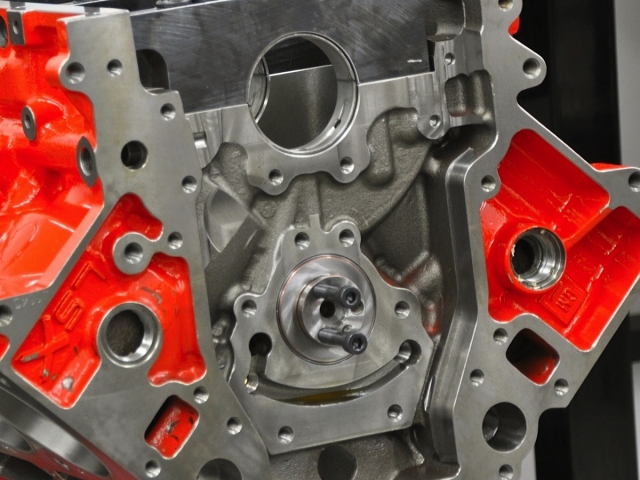 [15]
[15]The Comp Cams 60mm billet steel camshaft is installed. Cam specs were not released but it’s safe to assume the actual valve lift exceeds .900-inch.
The Jesel cam-gear hub was machined for a Torrington bearing, so cam endplay was double checked.
A special tool is used to press fit the bushings that support the lifters into the lifter bores. This process ensures that the lifter keyway is in correct alignment with the camshaft and to properly position the lifter wheel on the cam lobe.
“Once lifter bushing is in, we hone it to the proper clearance and cross hatch for oil retention,” adds Neelen.
Jesel developed the patented keyway lifters as an alternative to the tiebar and dogbone style roller lifters. The lifter body features a hardened keyway pin that rides in an index slot located in the bronze lifter bushing—keeping the lifter from rotating within the bushing.The lifters are constructed from DLC-coated tool steel and are available in three body diameters with various roller diameters. They can also be ordered with centered or offset pushrod seat locations. A larger roller wheel allows more aggressive camshaft lobe profiles.
Jesel .937 tool-steel, DLC-coated keyway lifters roll on top of the Comp cam. The lifters feature an .850-inch roller. Shown at the right are Jesel’s three styles of lifters withs the keyway on the far left. In middle is the dogbone (note the tall lifter bodies required) and the conventional tie-bar style. The keyway lifters eliminate the need for tie-bars to maintain alignment and are lighter than dog-bone-style lifters.
“You’re not dealing with a tie bar or guide bar to pair up the lifters,” says Kutch. “Now they’re individual and you can offset the lifter bores in the block to straighten pushrod angles or rotate the bore angle. If you do have different lifter-bore angles, at some point a tie-bar would bind. With a dogbone, you don’t have the binding issue. But the drawback to a dogbone is the added length of the lifter, which can cause clearance issues with large pushrods.”
No pole vaulting allowed
Next in line are the 3-piece Manton pushrods—9.590-inch intake, 9.780-inch exhaust. The are constructed from .188-wall heat-treated 4130/4135 chromoly steel and feature a 9/16-to-1/2-inch single taper for clearance. Here’s where much of the valvetrain strength is focused and the old theories of lightweight valvetrain components are challenged.
Even the quarter-mile teams are running spring oilers to control valve-spring heat.–Matt Milkovich, PAC Racing Springs
“You want as much strength and rigidity as possible in the pushrod. If the pushrod starts to flex, it can damage the lifter,” says Al Perkins of Manton Pushrods, noting that a weak pushrod can act like a pole vault motion or sequence. “Now you’ve put frequency into the valvetrain. The rocker will start to oscillate because it’s not stable. It’s always trying to find a new home.”
Pushrods in today’s Pro Mod engines are as large as 3/4-inch diameter with various degrees of taper. Top Fuel engines would love to see pushrods that fat, but rules keep engine builders from providing enough clearance to support that size. Even the 9/16 pushrod in Blown Z required additional clearance work in the cylinder head and on the underside of the rockers. That’s the extra effort required to ensure the rigidity of the system and not worry so much about weight.
Manton built the pushrods to match up with the Jesel lifters and rockers. The single taper (9/16- to 1/2-inch) 3-piece construction features with a copper radius cup on the rocker side and an extended 8620 steel tip on the lifter side for additional clearance. The tapering operation is shown on the far right.
“You have to remember, the pushrod is actually suspended mass between the lifter and rocker,” says Perkins, noting that intensive trial-and-error testing on the Spintron revealed that heavier, stronger pushrods didn’t affect the engine acceleration speed; but rather they helped maintain correct cam timing and improved the overall durability of the valvetrain components. “Weight, it turns out, wasn’t that much of a factor when the valve spring rates and rocker-arm ratios increased so much.”
Heat buildup can also be an issue with pushrods, especially on top where they apply pressure to the rocker arms. Manton installs a copper radius cup in the tip that offers a lower coefficient of friction between the pushrod and the tool-steel adjusting screw on the rocker.
Left: The lifters and pushrods are installed. Center: LME added high-pressure lubricant to the copper cup before the rockers were installed. Right: Note the Jesel tool-steel ball adjusters.
“The copper cup reduces the chances of a burned tip, especially when using thinner race oils,” adds Perkins, noting that the ductile characteristics of the copper also help the adjuster ball and pushrod cup conform in a more uniform pattern when pressure is applied.
Weight vs. strength
A shaft-mounted rocker arm is essential to meet the demands of a high-rpm, boosted engine, and Jesel offers three styles that juggle the weight vs. strength dilemma. There’s a solid-body style that provides maximum strength to reduce flex in the valvetrain, and there’s a “Mohawk Beam” design intended for high-revving applications. In the middle of these two choices is the standard-slot style that lightens up the rocker while offering a stiff body.
“If you’re looking for longevity and a rocker that won’t flex, then definitely a solid body,” advises Kutch. “On the exhaust side, especially with a blown engine, you’re dealing with extreme cylinder pressures and you want that rigidity. You should use a solid body rocker or even a steel rocker.”
Blown Z does utilize the Jesel aluminum solid-body Pro Series rocker with a 1.9:1 ratio on both the intake and exhaust valves. These rockers are constructed a proprietary blend of alloys and are delivered with a shot-peened surface that helps resist fatigue failures. Standard features include a clip-pin nose roller, tool-steel cup adjuster, Torx mounting hardware, alloy steel stands and needle bearings around the .561-inch shaft. Options include either a .335- or .250-inch wide needle nose roller—which help prevent the roller from stalling and skidding across the valve tip—ARP mounting hardware, ball-style adjuster and valve-spring relief pockets.
Left: Lighter versions of the Jesel shaft-mounted rocker are also available, including the slotted and Mohawk styles. MIddle: LME had to clearance the backside of the rockers for the pushrods. Right: Rocker arm position and motion were confirmed with a traditional Sharpie test.
Kutch says some engine builders use two different designs on the same head, mounting lightweight slotted or Mohawk on the intake and solid body on the exhaust.
“They’re trying to get the lowest moment of inertia on the intake,” adds Kutch.
Hints on the cam profile
Following consultation between LME and Comp, the 1.9:1 ratio was selected to complement the desired cam profile. The team is keeping the full specs under wraps but it’s safe to assume it’s a dual-pattern design with final lift at the valve exceeding .900-inch.
“With any boosted engine, we need to be able to estimate, or know, the pressure differential across the chamber just along with the typical camshaft selection drivers such as rpm range, cylinder head flow, valve sizes and bore and stoke,” says Godbold. “That boost-to-back-pressure ratio dictates how much overlap can be run without major reversion issues.”
PAC dual springs are held in place with titanium retainers.
To handle that much cam, PAC Racing Springs supplied a set of 1300 Series springs. This dual-spring arrangement features 1.500-inch diameter outer springs and 1.050-inch diameter inner springs. They come with an installed load rating of 350 pounds and 1,116 pounds open.
“When we came out the with the dual, everyone said it wouldn’t work,” remembers Matt Milkovich of PAC Racing Springs. “They said there’s no way you’re making dual live like a triple. Turned out that on certain applications the duals were outliving the triples.”
Constructed from a proprietary Kobe steel blend, the PAC springs are chamfered on the inside diameter to facilitate retainer clearance and reduce stress that could build on an edge. They also go through a “nano-peening” process to improve fatigue strength of the metal. Finally, the springs are secured with PAC’s 500-Series titanium retainers that are micropolished to also improve durability.
“In general, less valve-spring and retainer mass along with higher spring rate and higher frequencies usually relate to better valvetrain control,” says Milkovich. “You want the lowest loads and rates possible while still maintaining control of the valve.”
In some applications, too much spring pressure can have an adverse affect on engine performance.
“There were times we thought a higher-rate spring would work well,” adds Milkovich. “What happened was that it controlled the valve so well that it got rid of the ‘lofting’ and the engine lost high-end horsepower and reduced the rpm range.”
Avoiding heat
Even though Blown Z is a low 7-second car, there’s still enough time for heat to become a factor in valvetrain performance.
“Heat is definitely an issue with high rpm applications. Even the quarter-mile teams are running spring oilers to control valve-spring heat,” says Milkovich. “When you introduce heat to a spring, it loses rate and load based simply on the physical properties of the metal.”
The LSX block had to be machined to accept the Jesel belt drive. Most other applications do not require machining. Also, when installing the belt drive on a LSX engine, an external oil pump or dry sump system is required since the stock oil pump must be removed.
The Jesel belt drive is installed. The Blown Z team also installed a distributor drive that works with the cam gear when the engine was placed in the car.
PAC specs list not only the spring dimensions and rates but also the frequencies, which may not relate to all engine builders. For the record, the frequencies of Blown Z’s springs are 30,568 CPM (cycles per minute) for the outer spring and 35,649 CPM for the inner spring.
“For most builders they don’t need the frequencies,” says Milkovich. “But there are engine builders who use computer models to figure out what frequency of inner and outer spring they need.”
The last cog in the system is the valve, and here’s where lighter is better. Blown Z utilizes Ferrea titanium 2.250-inch intake valves and Super Alloy 1.600-inch exhaust valves. Again, a closer look at the valve and cylinder-head preparation, including the valve-angle cuts, can be found in an earlier story [38].
Finally, the cam has to be turned to get valvetrain in motion. That’s the job of Jesel’s belt-drive system that has numerous advantages over a traditional chain drive.
“There’s the ease of cam swaps and adjusting the cam timing. There’s no more taking off the cover to get to the cam,” sums up Kutch. “It’s stronger and reduces harmonic vibrations to the camshaft. Also, all the oil is behind the belt drive, so it’s cleaner.”
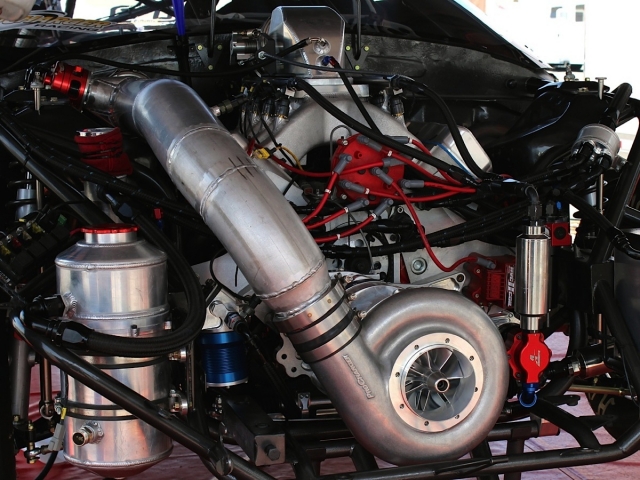 [39]
[39]The valvetrain in Blown Z’s 400ci LSX must withstand racing conditions approaching 30 pounds of boost.
